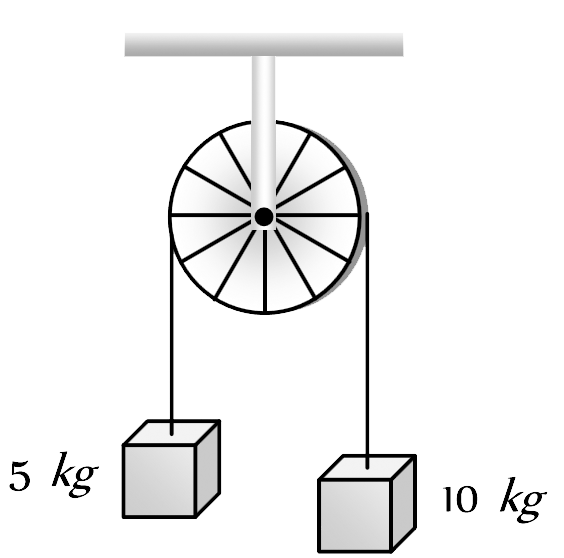A block of mass m rests on a rough horizontl surface as shown in figure (a) and (b). Coefficient of friciton between block and surface is μ. A force F-mg acting at an angle θ with the vertical side of the block. Find the condition for which block will move along the surface.
 Solution in Gujrati
Solution in Gujrati
For(a): normal reaction N=mg−mgcosθ fricitional force =μN=μ(mg−mgcosθ)
Now block can be pulled when : Horizontal component of force ≥ fricitional force i.e. mgsinθ≥μ(mg−mgcosθ)
or 2sin(θ)2cos(θ)2≥μ(1−cosθ)
or 2sin(θ)2cos(θ)2≥2μsin2(θ)2 or cot(θ)2≥μ
For (b): Normal reaction N=mg+mgcosθ=mg(1+cosθ) Hence, block can be pushed along the horizontal surface when horizontal component of force ≥ fricitional force
i.e. mgsinθ≥μmg(1+cosθ) or
2sin(θ)2cos(θ)2≥μ×2cos2(θ)2⇒tan(θ)2≥μ

Topper's Solved these Questions
- NEWTONS LAWS OF MOTIONBOOK - ALLEN CHAPTER - NEWTONS LAWS OF MOTIONEXERCISE - EXERCISE-I
52 Videos
- NEWTONS LAWS OF MOTIONBOOK - ALLEN CHAPTER - NEWTONS LAWS OF MOTIONEXERCISE - EXERCISE-II
112 Videos
- NEWTONS LAWS OF MOTIONBOOK - ALLEN CHAPTER - NEWTONS LAWS OF MOTIONEXERCISE - EXERCISE-III
28 Videos
- NEWTON'S LAWS OF MOTION & FRICTIONBOOK - ALLEN CHAPTER - NEWTON'S LAWS OF MOTION & FRICTIONEXERCISE - EXERCISE (JA)
4 Videos
- RACEBOOK - ALLEN CHAPTER - RACEEXERCISE - Basic Maths (Wave Motion & Dopplers Effect) (Stationary waves & doppler effect, beats)
25 Videos
Similar Questions
USS 150) Two masses of 5 kg and 10 kg are connected to a pulley as shown. What will be the acceleration of the system (g= acceleration due to gravity)

View SolutionA particle is in straight line motion with uniform velocity A force is not required
View SolutionAssertion: The driver in a vechicle moving with a constant speed on a straight road is in a non-inertial frame of referance.
Reason: A reference frame in which Newton's laws of motion are applicable is non-inertial.
View SolutionA piece of wire is bent in the shape of a parabola y=kx2 (y-axis vertical) with a bead of mass m on it. The bead can slide on the wire without friction. It stays at the lowest point of the parabola when the wire is at rest. The wire is now accelerated parallel to the x-axis with a constant acceleration a. The distance of the new equilibrium position of the bead, where the bead can stay at rest with respect to the wire, from the y-axis is:
View SolutionThe frequency of a radar is 780 MHz. After getting reflected from an approaching aeroplane, the apparent frequency is more than the actual frequency by 2.6 kHz. The aeroplane has a speed of
View SolutionA block of mass M is kept on as rough horizontal surface. The coefficient of static frictionbetween the block and the surface is μ. The block is to be pulled by applying a force to it. What minimum force is needed to slide the block? In which direction should this force act?
View SolutionA block of mass m lying on a rough horizontal surface of friction coefficient μ is pulled by a force F as shown , the limiting friction between the block and surface will be

View SolutionA block of mass M rests on a rough horizontal surface as shown. Coefficient of friction between the block and the surface is mu . A force F=mg acting at angle theta with the vertical side of the block pulls it. In which of the following cases the block can be pulled along the surface?
View SolutionA block of mass m is at rest on a rough inclined plane, whose friction coefficient is μ. Net force exerted by surface on block is :-
View SolutionA block of mass m is lying on horizontal surface of coefficient of friction mu. A force is applied to the block at an angle theta with the horizontal. The block will move with a minimum force F if
View SolutionWhat is the value of applied force ‘F’ which is exerted at an angle θ with the horizontal on a block of mass ‘m’ placed on a horizontal rough surface, if the coefficient of static friction between the block and the surface is , such that the block is on the verge of moving horizontally?

View SolutionA block of mass M is at rest on a rough horizontal surface. The coefficient of friction between the block and the surface is μ. A force F = Mg acting at an angle θ with the vertical side of the block pulls it. In which of the following cases, the block can be pulled along the surface?
View SolutionM द्रव्यमान का एक ब्लॉक एक रुक्ष सतह पर चित्रानुसार रखा है। ब्लॉक व सतह के बीच घर्षण गुणांक μ है। चित्रानुसार लगा बल F इसे खींचता है। निम्न में से किस स्थिति में, ब्लॉक को सतह के अनुदिश खींचा जा सकता है।

View SolutionA cubical block of mass 'm' rests on rough horizontal surface. μ is coefficient of static friction between block and the surface. A force "mg" acting on cube at an angle " θ" with vertical side of cube pulls the block. If the block is to be pulled along the surface then the value of cot(θ/2) is
View SolutionA cubical block of mass 'm' rests on rough horizontal surface. μ is coefficient of static friction between block and the surface. A force "mg" acting on cube at an angle " θ" with vertical side of cube pulls the block. If the block is to be pulled along the surface then the value of cot(θ/2) is
View SolutionA cubical block of mass 'm' rests on rough horizontal surface. mu is coefficient of static friction between block and the surface. A force "mg" acting on cube at an angle " theta " with vertical side of cube pulls the block. if the block is to be pulled along the surface then the value of cot (theta //2) is
View Solution
